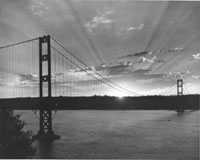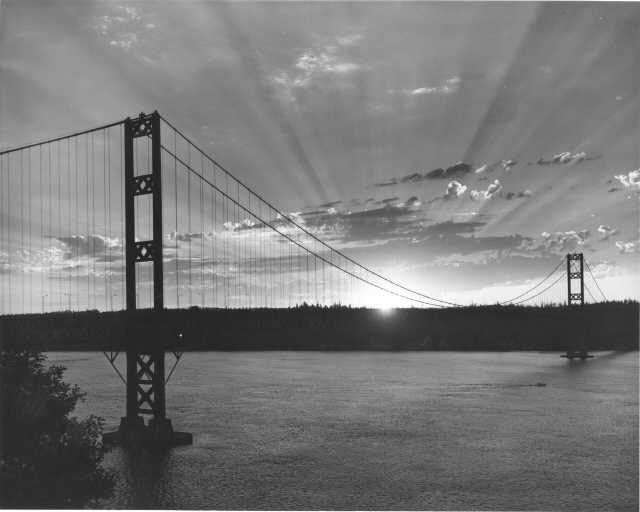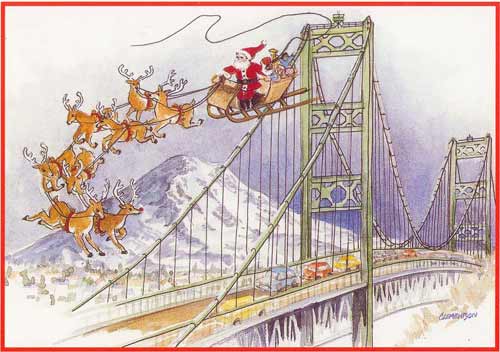Tacoma Narrows Bridge history - Art - Continuation
Art of the Bridges Continues
Both the 1940 and 1950 Narrows Bridges hold a special place in history, art, and the hearts of many.
What's here?

Bridge at sunset TPL 6661. The copyright in this image is the property of the Tacoma Public Library. Any additional copies or reproduction of this image are prohibited. All rights reserved
Gertie on film
Four different cameramen captured Galloping Gertie's spectacular collapse on motion picture film. They set their cameras on the bridge itself and nearby on the shore. The footage proved to be extremely valuable for scientific study of the bridge's failure.
The Camera Shop's owners, Barney Elliott and Harbine Monroe, got word that the bridge was in trouble. Each grabbed his Bell & Howell 16mm camera and several packets of the new and expensive "Kodachrome" color film. They drove to the Narrows Bridge as quickly as possible and began shooting. Elliott worked from the center and right side of the bridge, Monroe from the left. They sold the dramatic motion picture to Paramount Studios, which converted the color footage to black and white and distributed it to movie theaters around the world. "Castle Films" bought distribution rights and created thousands of 8-millimeter film copies for home viewing. The "Castle Films" version is easy to identify, with its dramatic title, "Disaster! The Greatest Camera Scoop of All Time." The Camera Shop's film became a "classic." Now, a color videotape version, condensed to eight minutes and covering shots from construction to destruction, is available for public purchase.
Walter Miles of the Pacific Bridge Company provided film footage during construction and afterwards for the State Toll Bridge Authority. Miles filmed Gertie's collapse on color film. Several hours of the Miles footage are in the WSDOT records at the Washington State Archives.
Professor F. B. Farquharson shot some of the most widely viewed film. It is housed at the University of Washington and is used for scholarly study only. Farquharson's film was also sold to newsreels and government agencies.
The still photographs remain the most prominent and dramatic images of Galloping Gertie's collapse. Howard Clifford, James Bashford, Richards Studios, and Professor Farquharson all took memorable photos. Farquharson's photographs are at the University of Washington (and available through the University Libraries on-line exhibit). Bashford's are at the Gig Harbor Peninsula Historical Society. Clifford's are the property of the Tacoma News Tribune. Tacoma Public Library holds the Richards Studio collection.
The striking photos and motion pictures of the failure of the 1940 Tacoma Narrows Bridge seem destined to fascinate viewers indefinitely. For over six decades the images have been shown around the world and have appeared in thousands of publications and Internet web sites.
The bridge and art in the community
Residents throughout Puget Sound heralded the opening of the 1950 Narrows Bridge. Especially delighted, of course, were residents of Tacoma and the Peninsula. Besides the customary parades, public speeches, and newspaper stories, the new bridge also appeared in several artistic forms around the community.

Model of the bridge in a raft, ready for the Tacoma and District Chrysanthemum Society flower show, October 1950 TPL 9505. The copyright in this image is the property of the Tacoma Public Library. Any additional copies or reproduction of this image are prohibited. All rights reserved

Artwork courtesy of seattlewatercolors.com
A model of the bridge, centered in a rubber raft, was built by men of the Tacoma Fire Department in October 1950 in preparation for the Tacoma and District annual Chrysanthemum Society flower show held October 7-8, 1950.
Artistic photographs appear prominently at the Gig Harbor street fair almost weekly during summer months. Numerous other items, from commemorative plates to T-shirts and even Christmas cards have featured the Narrows Bridge. The 50th Anniversary celebration for the bridge held in October 2000 provided the perfect occasion.
Even the 1940 bridge achieved minor "artistic" notoriety in the wider community. Galloping Gertie was celebrated in song, at least twice. At the opening day ceremonies on July 1, 1940 several bands played a march composed by the Gig Harbor postmaster. More prominent was a tune that was recorded and played on Northwest radio stations after Gertie's collapse—"The Ballad of Galloping Gertie." The song has since disappeared. Local music buffs are actively searching for a copy of the recording or sheet music.
The Singing Bridge
All suspension bridges can "sing." The main suspension cables and the suspender cables vibrate, just like a guitar string for example, except at a different tone. Normally, these vibrations are inaudible.
The "singing" Tacoma Narrows Bridge is part of a worldwide effort to record and offer this unique sound to the public. The idea is to create a "sonic sculpture," by capturing and amplifying the vibrations to where we can hear their sound.
Presenting the familiar structure of bridges like the Narrows Bridge in the form of sound is the work of artist Jodi Rose. She heads an international project that hopes to create a transforming experience for commuters and other listeners. Rose says, "Sounding the harmonic frequency within the unheard vibrations of the cables will release the voice and liberate the spirit of each bridge."
What does it sound like? Watch this site for a "sound bite" of the "singing Tacoma Narrows Bridge" in the near future.